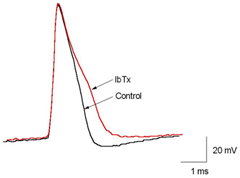
Brain signalling
Group home page at UiO
Group home page (old)
Our group is interested in brain function, from molecules to behavior. We study fundamental principles and mechanisms of neuronal signalling in the mammalian brain, and the roles of ion channels in behaviour, brain function, and disease. We focus on the functions of ion channels, in particular K+ channels, in central neurons and circuits, mainly in the hippocampus and cerebral cortex. Methods: Electrophysiological and optical recordings in brain slices and in vivo, molecular genetic and pharmacological manipulations, computational modelling, and behavioural tests.
Challenges
- To determine the functional roles and interplay of multiple signaling mechanisms and ion channel types within different neuronal compartments and within the entire neuron.
- To elucidate functional roles of specific neuronal populations, signaling mechanisms and ion channel types, in active neuronal networks, and in the brain of behaving animals.
- To elucidate the roles of neuronal signaling mechanisms in ageing and neurological disease, including neurodegenerative and ischemic disorders, epilepsy, and memory disorders.
Projects
- The roles of Kv7/KCNQ/M- and h/HCN-type K+ channels in neuronal signalling, brain oscillations, synaptic plasticity, cognitive functions and epilepsy.
- The roles of Ca2+-activated K+ channels (BK and SK channels) in neuronal signalling, synaptic plasticity, cognitive functions, motor control, epilepsy and neuroprotection.
- The roles of voltage-gated ion channels in neuronal signalling, synaptic plasticity, learning and memory.
- Changes in neuronal signalling during ontogenetic development and ageing.
Recent achievements
Discovered that Kv7/M/KCNQ-type K+ channels are present in the perisomatic region but not in the apical dendrites of hippocampal pyramidal neurons (Hu et al., J. Neuroscience, 2007). Discovered that the persistent sodium current, INaP, paradoxically amplifies afterhyperpolarizations and reduces the frequency (f/I) gain, and strongly modulates spike timing (Vervaeke et al., Neuron 2006); that Kv7/M/KCNQ-type K+ channels but not SK channels are essential for excitability control in hippocampal neurons (Gu et al., J Physiol, 2005); that Kv7/M/KCNQ-type K+ channels are essential for spatial learning and prevention of epilepsy (Nature Neuroscience 8: 51-60, 2005), that KCa1/BK-type K+ channels are essential for cerebellar learning and motor control (Proc Natl Acad Sci USA 101: 0474-8, 2004), the role of postsynaptic voltage-gated K+ channels in regulation of synaptic plasticity (LTP) and integration (Proc Natl Acad Sci USA 99:10144, 2002); that Kv7/M/KCNQ-type K+ channels are essential for intrinsic theta resonance in hippocampal neurons (J Physiol 545:783, 2002).
Group leader
 Professor
Johan F. Storm
Professor
Johan F. Storm
Department of Physiology & CMBN
University of Oslo
PO Box 1103 Blindern
NO-0317 Oslo
Norway
Tel: +47 22851246
Fax: +47 22851249
E-mail: j.f.storm@medisin.uio.no

Action potentials in brain neuron (hippocampal pyramidal cell) before and after blockade of BK- type (potassium) channels.
PO Box 1105 Blindern, NO-0317 Oslo, Norway. Tel: +47 22851528. Fax: +47 22851488